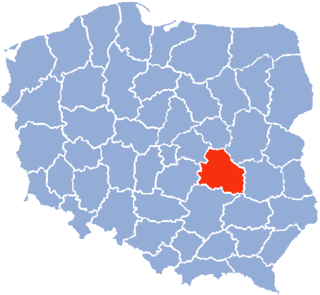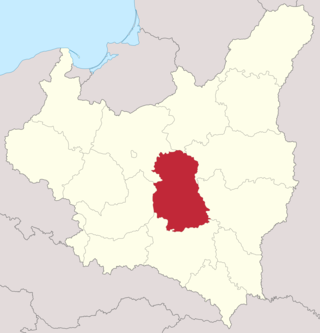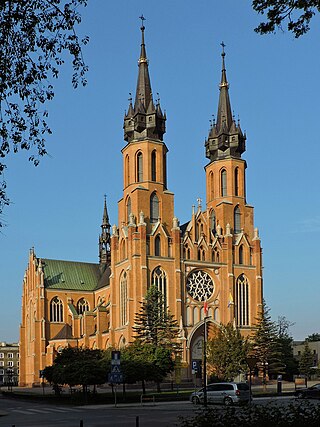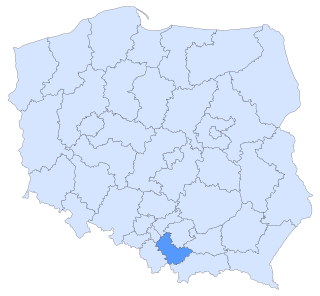
Radom is a city in east-central Poland, located approximately 100 kilometres south of the capital, Warsaw. It is situated on the Mleczna River in the Masovian Voivodeship. Radom is the fifteenth-largest city in Poland and the second-largest in its province with a population of 196,918 (30.06.2023)

Kielce Voivodeship is a former unit of administrative division and the local government in Poland. It was originally formed during Poland's return to independence in the aftermath of World War One, and recreated within the new Polish borders after the defeat of Nazi Germany in World War Two.

Radom Voivodeship was a unit of administrative division and local government in Poland in the years 1975–1998, superseded by Masovian Voivodeship. Its capital city was Radom.

The Ruthenian Voivodeship, also called Rus’ voivodeship, was a voivodeship of the Crown of the Kingdom of Poland from 1434 until the 1772 First Partition of Poland with a center in the city of Lviv. Together with a number of other voivodeships of southern and eastern part of the Kingdom of Poland, it formed Lesser Poland Province, with its capital city in Kraków. Following the Partitions of Poland, most of Ruthenian Voivodeship, except for its northeastern corner, was annexed by the Habsburg monarchy, as part of the province of Galicia. Today, the former Ruthenian Voivodeship is divided between Poland and Ukraine.

Posen was the southern of two Prussian administrative regions, or Regierungsbezirke, of the Grand Duchy of Posen (1815–1849) and its successor, the Province of Posen (1849–1918). The administrative region was bordered on the north by Regierungsbezirk Bromberg, to the west by the Province of Brandenburg, to the south by the Silesia Province, and to the east by Russian Congress Poland.
Nihil novi nisi commune consensu is the original Latin title of a 1505 act or constitution adopted by the Polish Sejm (parliament), meeting in the royal castle at Radom.

Sandomierz Voivodeship was a unit of administration and local government in Poland from the 14th century to the partitions of Poland in 1772–1795. It was part of the Lesser Poland region and the Lesser Poland Province. Originally Sandomierz Voivodeship also covered the area around Lublin, but in 1474 its three eastern counties were organized into Lublin Voivodeship. In the 16th century, it had 374 parishes, 100 towns and 2586 villages. The voivodeship was based on the Sandomerz ziemia, which earlier was the Duchy of Sandomierz. The Duchy of Sandomierz was created in 1138 by King Bolesław III Wrymouth, who in his testament divided Poland into five principalities. One of them, with the capital at Sandomierz, was assigned to Krzywousty's son, Henry of Sandomierz. Later on, with southern part of the Seniorate Province, the Duchy of Sandomierz created Lesser Poland, divided into Kraków and Sandomierz Voivodeships.

Radom Department was a unit of administrative division and local government in Polish Duchy of Warsaw in years 1809–1815.
Radom Confederation was a konfederacja of nobility (szlachta) in the Polish–Lithuanian Commonwealth formed in Radom on 23 June 1767 to prevent reforms and defend the Golden Liberties. It was formed by Russian envoy to Poland Nicholas Repnin and backed by the Russian Imperial Army as a response of Catholic nobility to the earlier Protestant confederations of Slutzk and Toruń, approximately 74,000 nobles declared their support for Radom Confederation.
The Słuck Confederation was a confederation formed in Slutsk on 20 March 1767 by the Protestant (Calvinist) szlachta of the Great Duchy of Lithuania. Its marshal was Paweł Grabowski. Supported by the Russian army, it contributed to the destabilization of the Polish–Lithuanian Commonwealth, formation of the Radom Confederation and to the collapse of the reforms of the Convocation Sejm (1764).

Kielce Voivodeship - a unit of administrative division and local government in Poland in years 1921–1939. At that time, it covered northern counties of the historic province of Lesser Poland, including such cities as Radom, Częstochowa and Sosnowiec. On 1 April 1938, its borders changed, see: Territorial changes of Polish Voivodeships on 1 April 1938. Capital city: Kielce.

Lublin Voivodeship was a unit of administrative division of the Second Polish Republic between the two world wars, in the years 1919–1939. The province's capital and biggest city was Lublin.

Radom Governorate was an administrative-territorial unit (guberniya) of Congress Poland of the Russian Empire.

Vilar de Canes is a municipality in the comarca of Alt Maestrat, Castellón, Valencia, Spain.
Gmina Jastrzębia is a rural gmina in Radom County, Masovian Voivodeship, in east-central Poland. Its seat is the village of Jastrzębia, which lies approximately 12 kilometres (7 mi) north-east of Radom and 83 km (51 mi) south of Warsaw.

The Diocese of Radom is a Latin Church diocese of the Catholic Church located in the city of Radom in the ecclesiastical province of Częstochowa in Poland.

Sejm Constituency no. 12 elects 8 deputies to the Sejm and covers geographical area of following counties within western part of the Lesser Poland Voivodeship: Chrzanów, Myślenice, Oświęcim, Sucha and Wadowice.
Radom Synagogue was an Orthodox Synagogue in Radom, Poland, destroyed by Nazi Germany following the invasion of Poland in World War II. The Synagogue was located at Podwalna Street, previously named the Bożnicza Street. It was built in 1846, and burned to the ground in 1939 when the Radom Ghetto was set up. Almost all Radom Jews perished during the Holocaust in occupied Poland resulting in nearly complete abandonment of the site. After the end of war, the ruins of the Synagogue were dismantled on the orders of the local pro-Soviet communist government.
The Stadion im. Braci Czachorów, also known as the Stadion Miejski w Radomiu, is located in Radom, Poland. It is currently used mostly for association football matches and is the home ground of Radomiak Radom. Its reconstruction started in May 2017, and is not over yet. First phase was opened in August 2023 for Radomiak's home game against Cracovia.













